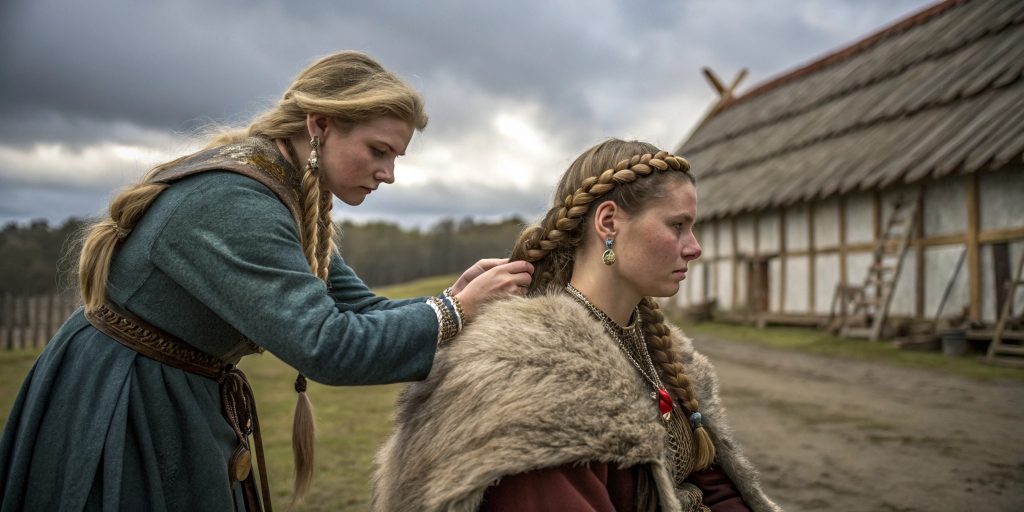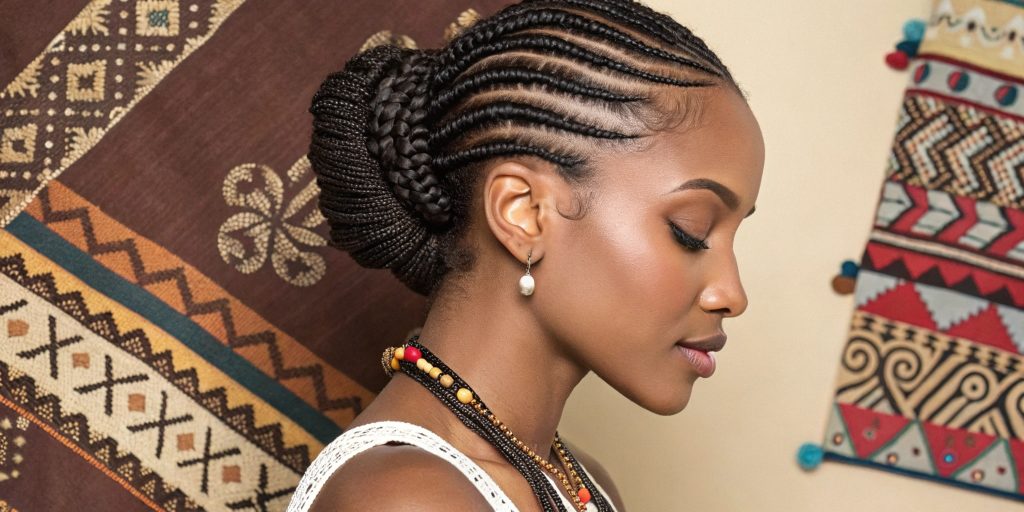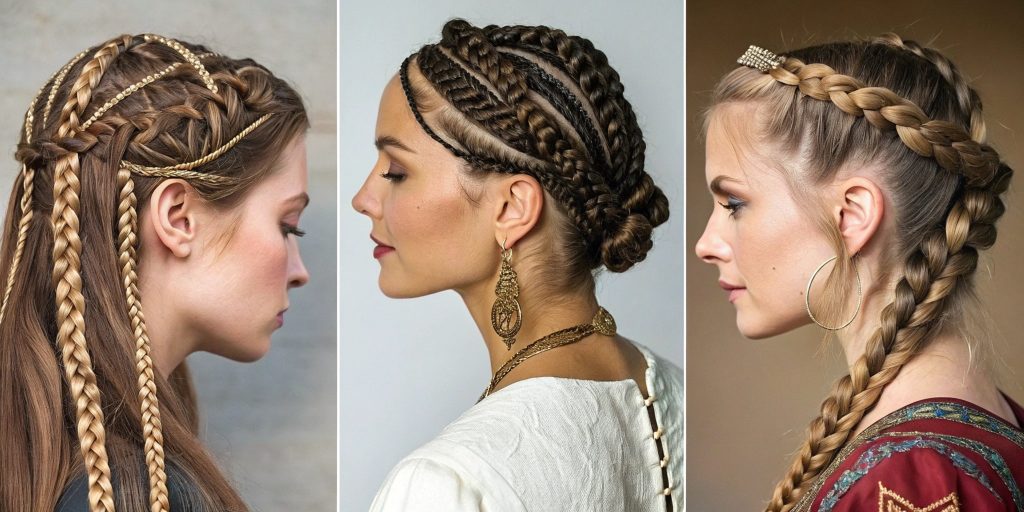Daily Life in the Viking Age, Vikings
Did the Vikings Invent Hair Braiding?
Many wonder if the Vikings were the first to braid hair. They were known for exploring and meeting many cultures, greatly impacting many parts of life, including hairstyles.
This section examines the Vikings and hair braiding. It sets the stage for learning about braiding’s origins. We’ll see if the Vikings were true innovators or part of a bigger hairstyling tradition.
Introduction to Hair Braiding
Hair braiding is a way to express yourself, showing off your style and cultural roots. It’s more than just a hairstyle; it’s a tradition that spans many cultures and times. Historically, braiding has changed from a simple task to a form of art.
Braids have different meanings in different places. Some mark important life events, while others are just for everyday looks. As times changed, so did how people styled their hair, showing their values and beliefs.
Hair braiding has stood the test of time, connecting families and communities. Each braid has its own story, weaving together personal and cultural identities.
What Are Braids? Understanding the Basics
Braids are a key hair technique found worldwide. They involve weaving three or more strands of hair together. This art showcases individuality, community, and cultural identity in many styles.
Definition and Significance of Braids
Braids mean more than looks; they show status, heritage, and personal style. In the past, they carried messages about identity and belonging. Today, they stay relevant, blending old traditions with new trends.
Different Styles and Techniques
Braid styles are a showcase of hair creativity. Some favorites include:
- French braids: Known for their elegant and intricate weaving.
- Fishtail braids: Characterized by a unique crisscross pattern.
- Cornrows: Close-to-the-scalp braids that can form various designs.
These styles show braiding’s flexibility. People can pick styles based on taste or cultural importance. As traditions grow, so do the ways to make beautiful braids, adding to the art with each new generation.
The Fascinating History of Braids
The history of braids goes back thousands of years. It shows how hair styling and culture are linked. In ancient times, braids were a big part of many cultures, showing off art and status.
In ancient Africa, braids were both useful and beautiful. They showed who was in the community, how old someone was, and if they were married. The Egyptians also loved braids, using them to show off their wealth. They even added gems and gold to their hair.
As time went on, braiding became more complex. New materials and tools made braids even more special, showing how technology and culture grew together.
The history of braids is truly amazing. It’s not just about hair. It’s about identity, community, and heritage through the ages.
Where Did Hair Braiding Originate?
Hair braiding has a long history, showcasing the beauty of different cultures. It’s a way to express oneself through art, and this practice has been important in many societies.
Connections Between Different Cultures
Cultures around the world have shared hair-braiding traditions. Each group’s style reflects its status, age, and heritage. In Africa, braids show which tribe one belongs to.
In ancient Greece and the Near East, braids meant different things. They showed life stages and social roles, which shows how braiding connected people across time and space.
Hair Braiding in Ancient Societies
In ancient times, braiding was vital to who you were and where you belonged. Ancient Egypt’s braids told stories of marriage and social standing. As braiding spread, it changed, adding to the beauty of hair styling everywhere.
Vikings and Their Hair Braiding Practices
The Vikings had many useful hairstyles that showed their culture. Men and women braided their hair to show who they were and their societal place. These braids also showed the many cultures the Vikings met on their travels.

Common Hairstyles Among Vikings
Viking hairstyles were different for everyone. They matched their role in society and what they liked. Here are some common styles:
- Long, flowing hair with intricate braids.
- Warriors had tight braids to keep hair out of their faces in battle.
- Noblemen wore braids with jewelry or decorative cords to show their status.
- Women had many braiding styles that showed their social standing.
Viking Cultural Influences on Braiding
The Vikings met many cultures on their travels. This changed their braiding techniques. They mixed styles from Byzantine, Celtic, and others into their own.
This mix made Viking braiding unique. It showed their love for different cultures and their ability to adapt.
Influence of African Culture on Hair Braiding
African culture deeply influences hair braiding, combining social meaning and art. In many African communities, braids tell a person’s story, heritage, and ties to others. These styles are more than looks; they are a way to express culture, blending old and new.
Styles like Fulani braids and Ghana braids mean a lot. They show a person’s status, age, or tribe, keeping braiding traditions alive. The detailed patterns and methods show the skill passed down through the years, celebrating personal and shared stories.
African Americans adopting these braiding traditions has led to new hairstyles that fit today’s fashion. This mix of history and modern style sparks talks about cultural sharing. It honors African culture while showing its influence on hair designs today.
Historical Evidence: When Did Braids Originate?
Hair braiding started in ancient times, with evidence from 3500 B.C. in Africa. Back then, braids were more than just a style. They helped manage hair and showed personal expression.

Over time, different places had their braiding styles. For example, ancient Egyptians loved braids. They used them to show status and identity.
- Ancient Africa: Practical uses and social meanings
- Egypt: Symbolism and hierarchy in hairstyles
- Europe: Different techniques reflecting local traditions
Braids have a common thread across cultures. Braids tell stories of cultural exchange from Africa to Europe and the Americas. They show how hair has been used to express identity and culture for centuries.
Evolution of Hair Braiding Techniques
The history of braiding is both fascinating and meaningful. It shows how culture and creativity in hair styling have grown. From old times to today, braids have changed a lot. This is thanks to new tools, materials, and a love for expressing oneself.
From Ancient Times to Modern Trends
In the past, braids were more than just hairstyles. They showed a person’s social standing and cultural roots. Today, we see braids like box braids and goddess braids. These styles let people show their unique selves while honoring their heritage.
How Styles of Braids Have Changed
Modern braids are shaped by pop culture, fashion, and social media. These factors keep changing hairstyles. This change shows how we connect to the past while being creative today.

